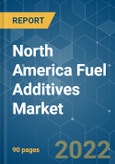The North America fuel additives market is estimated to witness a significant growth, at an estimated CAGR of around 4%, over the forecast period. Major factors driving the market studied are the enactment of stringent environmental regulations.
Key Highlights
- Increasing demand and penetration of battery electric vehicles (BEVs) are projected to hinder the market growth in the coming years.
- Accelerating demand for ultra-low-sulfur diesel (ULSD) is likely to create opportunities to the market in the future.
- United States accounted for the largest market share and is expected to continue domination during the forecast period.
Key Market Trends
Gasoline to Dominate the Market
- Gasoline is the major application of fuel additives in terms of market share. Gasoline engine technologies and fuels are constantly evolving and providing new challenges. The growth in the consumption of gasoline additive largely reflects the requirements of engine design and developments in refinery operations. Also, the additive cost is less than 0.3% of the average retail gasoline price.
- The increasing popularity of new age fuel delivery systems, like gasoline direct injection (GDI) system, is likely to boost the demand for fuel additives.
- Port injection fuel delivery systems used to be the norm. However, new gasoline direct injection or GDI technology is becoming standard equipment on many new cars, especially in high-performance vehicles. In this innovative fuel delivery system, the injector is placed inside the combustion chamber yielding improved combustion to produce better performance, improved gas mileage, and fewer emissions. Deposits in GDI systems are extremely hard to remove and require more fuel additives.
- The market penetration of gasoline direct injection (GDI) engines is growing rapidly, which is quite instrumental in propelling the market demand for gasoline fuel additives, in significant amount.
- Hence, owing to the above-mentioned reasons, the gasoline-related applications of fuel additives are likely to account for the highest market share, during the forecast period.
United States to Dominate the Market
- In the North America region, United States dominated the fuel additives market. United States is one of the fastest emerging economies and has become one of the biggest production houses in the world, today. The country’s manufacturing sector is one of the major contributors to the country’s economy.
- According to the Federal Aviation Administration (FAA), the total commercial aircraft fleet is expected to reach 8,270 in 2037, owing to the growth in air cargo. Also, the US mainliner carrier fleet is expected to grow at a rate of 54 aircrafts per year due to the existing fleet getting older. Strong exports of aerospace components to countries, such as France, China, and Germany, along with robust consumer spending in the United States are driving the manufacturing activities in the aerospace industry.
- Various automotive manufacturers are planning to invest during the coming years, amid threats from the government to increase levies on auto imports from Mexico. This factor is expected to positively impact the automotive industry in the country in the coming years, thereby increasing the consumption of fuel additives in the automotive industry through the forecast period.
- Due to all such factors, the market for fuel additives in the country is expected to have a steady growth during the forecast period.
Competitive Landscape
The North America fuel additives market is partially consolidated in nature. The major companies include Afton Chemical, The Lubrizol Corporation, Innospec Inc., BASF SE, and LANXESS, among others.
Additional Benefits:
- The market estimate (ME) sheet in Excel format
- 3 months of analyst support
This product will be delivered within 2 business days.








